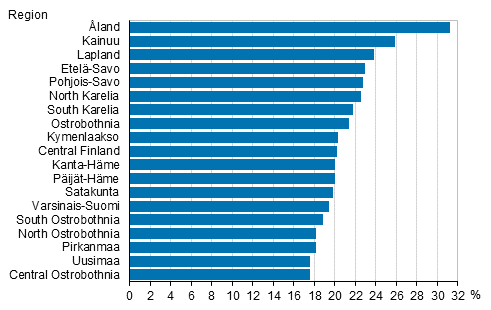4. Differences between regions in family types — married couple still the most common one
4.1 Number of cohabiting families lowest in Central Ostrobothnia
The commonest type of family with children in all regions is one of a married couple although there are also clear differences in this. The differences arise from the prevalence of families of cohabiting couples and one-parent families in the regions. In relative numbers, most cohabiting couples are found in �land, Kainuu and Lapland. In �land, 31 per cent and in Kainuu, 26 per cent and in Lapland, 24 per cent of all families with underage children are families of cohabiting couples. The lowest share of cohabiting families in Finland is found in Central Ostrobothnia, 18 per cent.
Figur 7. Families of cohabiting couples as a proportions of families with underage children by region in 2015

When examining the prevalence of cohabiting couples by municipality, the municipalities of �land are in the lead. Among municipalities in Mainland Finland, Pelkosenniemi holds the lead with 40 per cent of families with underage children cohabiting. After Pelkosenniemi, the number of families of cohabiting couples was in relative terms highest in Savukoski (35%) and N�rpi� (34%). The municipality in Mainland Finland with the lowest share of six per cent of families of cohabiting couples with children is Luoto.
4.2 One-parent families most common in P�ij�t-H�me
There is also clear regional variation in the prevalence of one-parent families. The number of one-parent families is in relative terms lowest in the region of Ostrobothnia, 14 per cent of families with children (Figure 8). The number of one-parent families is highest in P�ij�t-H�me (24%) and Uusimaa (23%).
Figure 8. Proportion of single-parent families of all families with underage children by region in 2015

The regional variation in the proportion of one-parent families with children is mostly due to the different proportions of families of the type mother and children. The proportion of families of the type father and children ranges from two to four per cent in all regions. The proportions are biggest in �land (3.7%), South Karelia (3.5%) and Kainuu (3.5%).
Examined by municipality in Mainland Finland, the proportions of one-parent families with children are highest in Helsinki, Hirvensalmi and Hartola (28%). The percentages are also high in some of �land's municipalities, but most of the municipalities are so small that a change of a few families’ type may change the percentages. The share of one-parent families was 27 per cent in Mariehamn.
In relative terms, Luoto (5%) and Peders�re (6%) have the lowest number of one-parent families with underage children in Mainland Finland.
Luoto could be viewed as the most conventional municipality in terms of family structure, because it has the lowest proportion of one-parent families with children (5%) and the highest proportion of married couples (89%) in the whole country. Luoto also has the sixth highest average number of 2.7 of underage children living at home per family. The number of underage children living at home was highest in Perho, Lumijoki and Sievi, 3.0, on average. The average for the whole country is 1.8.
Source: Population and Justice Statistics, Statistics Finland
Inquiries: Eevi Lappalainen 029 551 3367, Timo Nikander 029 551 3250 , Marjut Pietil�inen 029 551 2798, info@stat.fi
Director in charge: Jari Tarkoma
Updated 25.11.2016
Official Statistics of Finland (OSF):
Families [e-publication].
ISSN=1798-3231. Annual Review 2015,
4. Differences between regions in family types — married couple still the most common one
. Helsinki: Statistics Finland [referred: 19.4.2025].
Access method: http://stat.fi/til/perh/2015/02/perh_2015_02_2016-11-25_kat_004_en.html

